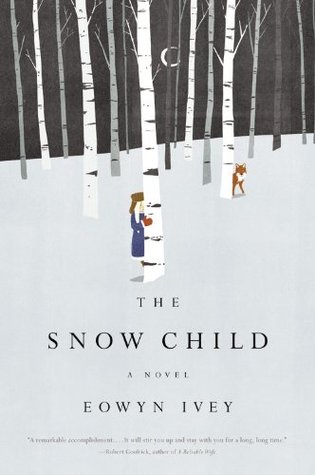Tags

4/5 stars
The Snow Child begins quite bleakly. Mabel and her husband Jack are struggling on a remote piece of land in Alaska to eke out a life. A life that they chose over living on Jack’s family farm among numerous family members in a warmer climate. The first pages walk you through Mabel’s attempted suicide. She decides that she wants to die by falling into an icy river. Tempting fate across frozen but thinning ice, Mabel makes it to the mountain side without falling through. Then she must make the trek back to her rough cabin home to clean and cook as she always has for her husband. There is little love or even acknowledgement between Mabel and Jack anymore. Their sparse interactions leave you feeling as alone and cold as the Alaskan wilderness they inhabit which is made all the more so depressing when the couple recalls her giving birth to a stillborn child, the spark that made them move in the first place, years earlier. The agreement being that they will work hard and live sparse, but they will have something of their own. Jack breaks that agreement by accepting an invitation to another family homestead to Mabel’s silent horror.
One evening Mabel is entranced by the thick snowfall and goes outside. Swept up by a peculiar sensation, Mabel inadvertently begins a snowball fight with Jack (to his surprise), which then turns into building a small snow girl. The magic of the evening not only rekindles a spark between them, but seemingly one with the snow itself. The next morning, footprints emerge from the crumpled snow girl and hints of a little girl running through the woods begin to make Mabel and Jack believe there is a girl in the woods. The notion of a book being at the center of The Snow Child played well with my bibliophilia and warmed me in the midst of this cold environment (both within the book and without).
“…perhaps there is no harm in finding magic among the trees.”
The Snow Child dips its toes into the fairy tale realm (in the true fashion of an unabridged, “un-Disney-fied” fairy tale)–and indeed is rooted in the Russian fairy tale of Snegurochka (The Snow Maiden)–with innocence, magic, and nature, but it also is set within the historic setting of 1920’s Alaska, to form a delicately woven and almost living story. The noticeable lack of speaking quotations when the snow child Faina is in the scene plays well on the magical realism the story creates. It made me feel as if their conversations were happening in their minds. As if they were thinking together without even noticing it. Not necessarily telepathy, but as if their thoughts were let out into an open room as normally as a voice would be. There is some connection between that feeling of openness in speaking with Faina and the vastness of the Alaskan wilderness, but I cannot seem to put it properly into words.
At first, I was a little put off by The Snow Child. The depressing and suicidal beginning was not conducive to the mood I was in. I didn’t want to read about a woman feeling displaced in society (and therefore was thought of and felt worthless) because she could not have children. However, I went with it. I wanted to know where the titular snow child comes into play and, in all honesty, the little red fox caught my attention, too. How does this all come together? As I read on, Ivey plays with the magical realism. Is Faina really magic or is she just a normal, lost little girl?
The Snow Child reminded me of the sad but magical story of Lady Amalthea in The Last Unicorn. The un-glamorous and brittle struggle between mortals and magic.
To gain an even deeper reading of the book, it should be read in the wintertime. When you can feel the chill in the air, see the snow piled up, and make out the tracks of wild animals in the early morning.
